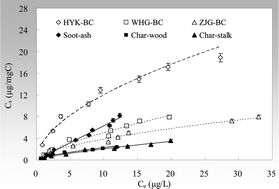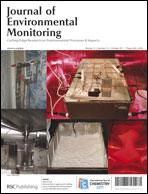Black carbon (BC) is known as a strong sorbent for the sorption of planar hydrophobic organic compounds (HOCs), but there is very little information about the sorption of nonplanar HOCs on BC. In this study, the sorption of di-(2-ethyl-hexyl) phthalate (DEHP), one kind of nonplanar phthalate acid ester (PAE), by environmental BC collected from river sediments and pure BC (char-wood, char-stalk and soot-ash) was investigated. Strong and nonlinear sorption was observed for the sorption of DEHP on both pure BC and environmental BC with the Freundlich exponent ranging from 0.55 to 0.75 except for soot-ash, and the measured KBC (BC–water partition coefficient) of DEHP was about one order of magnitude higher than its organic carbon–water partition coefficient. There was a significant difference in sorption capacity among the environmental and pure BC. The presence of di-methyl phthalate (DMP) could significantly decrease the sorption of DEHP on BC, especially for environmental BC. In addition, the contribution of BC to the total sorption of DEHP on original river sediments was more than 50% when the equilibrium concentration of DEHP was less than 10 μg L−1. This study indicated that ortho-substituted nonplanar PAEs could also be strongly sorbed by BC, and the difference in sorption among the BC samples revealed that it is important to take the source of BC into account when assessing its effects on the fate of HOCs in aquatic environment.

You have access to this article
 Please wait while we load your content...
Something went wrong. Try again?
Please wait while we load your content...
Something went wrong. Try again?


 Please wait while we load your content...
Please wait while we load your content...